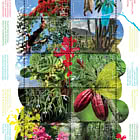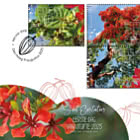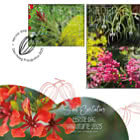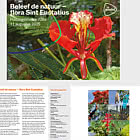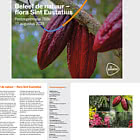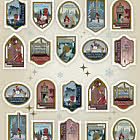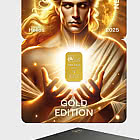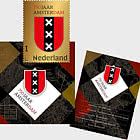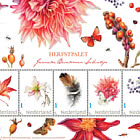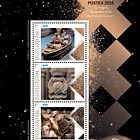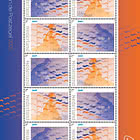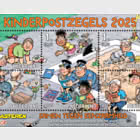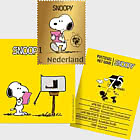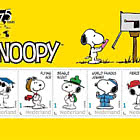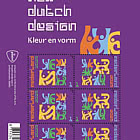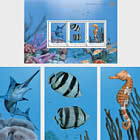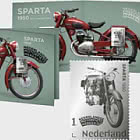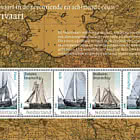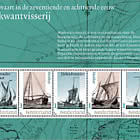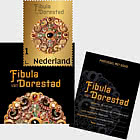- Home
- Stamps
- Netherlands
- 2025
Experience Nature - Flora Sint Eustatius
On 10 August 2025, PostNL will issue Experience Nature – flora Sint Eustatius, a sheet featuring 10 stamps in 10 different designs. The stamps have a denomination of 1 for mail up to 20 grams within the Netherlands. The price for a sheet of 10 stamps is €13.10. This stamp sheet about the butterflies of Sint Eustatius is part of the multi-year series Experience Nature dedicated to the Caribbean Netherlands from 2024-2026. Each year, the series features four stamp sheets, each with 10 different stamps.
The stamps depict plants and animals found in this part of the Netherlands. The islands in this region boast an extraordinary biodiversity by Dutch standards, with thousands of plant and animal species. In 2025, attention will be given to the birds, butterflies, underwater world, and flora of the island of Sint Eustatius. PostNL has already issued 3 stamp sheets in the series this year, about the birds (2 January), the butterflies (10 March), and the underwater life (9 June) of the island. On the final stamp sheet of 2025, Experience Nature – flora of Sint Eustatius, the spotlight is on the following trees and plants: flamboyant tree, kapok tree, Tourist Tree, Columnar Cactus, sea grape, Giant Airplant, Eyelash Orchid, cocoa tree, coral vine, and Strangler Fig.
SINT EUSTATIUS
The island of Sint Eustatius, like Bonaire and Saba, has a special status within the Netherlands. The collective name for the three islands is the Caribbean Netherlands. Together with the countries Aruba, Curaçao, and Sint Maarten, they form the Caribbean part of the Kingdom. Sint Eustatius, known locally as Statia, is part of the Leeward Islands. This designation refers to the position of the islands relative to the prevailing northeast trade winds. Sint Eustatius lies between Saba and Saint Kitts, separated from these islands by a shallow sea. The only city and capital of Sint Eustatius is Oranjestad. Since 2010, Sint Eustatius has been a special municipality, with the island council as the highest governing body responsible for local legislation. The executive power lies with the island commissioners appointed by the island council, chaired by the governor. About 3,000 people live on Sint Eustatius, and the island's official language is English. Sint Eustatius is dominated by the dormant volcano The Quill (601 meters) in the southeast and a 200,000-year-old extinct volcanic area in the north around the hill Bergje (223 meters). There are three national parks on the island: Quill/Boven National Park, Statia National Marine Park, and Miriam Schmidt Botanical Garden.
FLORA OF SINT EUSTATIUS
Sint Eustatius has various landscapes, with volcanic areas in the northwest and southeast, and in between a plain that slopes northward. The greatest variety in vegetation on the island is found on the slopes of the dormant volcano The Quill, in the southeast. Here lies tropical rainforest with mahogany trees, beard mosses, and tree ferns. In this dense, tropical rainforest, many bromeliads, orchids, and other epiphytic plants grow on the branches of the trees, meaning they do not need soil to survive. The outer wall of the crater and the slopes below it are covered with different forest types, ranging from dry to moist and from evergreen to deciduous. The vegetation of the plain in the middle consists of open to very dense shrubland, interspersed with extensive grasslands. Here, partially feral goats, donkeys, cattle, and sheep graze almost year-round. The vegetation of the northern part of the island consists of open to dense thorn shrub vegetation, interspersed with open grass vegetation and bare rocks. Due to the strong wind, shrubs here often grow no taller than 50 centimetres. On Sint Eustatius, flowers bloom all year round because the island has no seasons. For a small island, biodiversity is high, with a total of 500 higher plant species and over 75 plant families.
Source: landenweb.nl, Naturalis, Vakblad Natuur Bos Landschap, Wikipedia
DESIGN
The stamp sheet Experience Nature – Flora of Sint Eustatius is designed by graphic designer Frank Janse from Gouda. On the sheet, all trees and plants are portrayed in their natural environment, each on their own stamp. These are the following 10 species: flamboyant tree, kapok tree, Tourist Tree, Columnar Cactus, sea grape, Giant Airplant, Eyelash Orchid, cocoa tree, coral vine, and Strangler Fig. All photos are placed in a graphic layer with circular shapes that are also visible on the sheet border. The image sometimes continues onto the adjacent stamp and the sheet border. In various places on the stamp sheet, the designer has added graphic elements derived from symbols on old topographic maps. These symbols indicate, for example, landscape forms, contour lines, vegetation, soil structures, and watercourses. The design is also characterised by an extra transparent layer with monochrome images (both white and in colour) of characteristic flora and fauna from this area. The monochrome images are rendered almost abstractly, extend across the perforations, and connect the stamps with each other and with the sheet border. The following plants and animals are depicted in this way: sea grape (top left), Green-throated Carib (top right), coral vine (middle and bottom right), Cloudless Sulphur Butterfly (middle right), flower of the kapok tree (bottom left), and leaf of the flamboyant tree (middle bottom).
TYPOGRAPHY
For the typography, the DIN 2014 font was used, designed by Vasily Biryukov from Bulgaria and released by Paratype in 2015. In the captions on the stamp sheet, designer Frank Janse creatively and humorously expresses his associations with the names, characteristics, and appearances of the depicted trees and plants.
DESIGNER
In 2024, 2025, and 2026, the stamp series Experience Nature focuses on the plants and animals of the Caribbean Netherlands. In 2024, the Leeward island of Bonaire kicked off the series, and this year, attention is on the nature of the Windward island of Sint Eustatius, located over 800 kilometres northeast of Bonaire.
Explosive colours
The stamps about the flora of Sint Eustatius are the last of this year in the Experience Nature series. The 2025 stamp sheets were once again designed by graphic designer Frank Janse, as always within the existing design concept for the stamp series. For the Experience Nature series about the Caribbean Netherlands, a selection of all animals and plants for the islands to be featured—Bonaire, Sint Eustatius, and Saba—was already made in 2023. When choosing the species to be depicted, Janse always tries to create interesting combinations, with as much variety as possible. “The differences between the stamp sheets about Sint Eustatius become clearly visible when you place all four next to each other,” says Janse. “Butterflies, for example, can easily be shown in full on a stamp, whereas that can be more difficult with birds if you want to create an interesting image. With the birds and butterflies, the main subjects dominate the overall image much more than underwater and with the flora. They also each have their own colour scheme. With blue and green for the birds, bright colours for the butterflies, and of course sea blue for the underwater life. With photos of flowering plants, the colours always pop, especially in the Caribbean Netherlands. On this stamp sheet about the trees and plants of Sint Eustatius, red dominates, with yellow as a supporting colour.”
Busy backgrounds
In the design choices for the stamp sheets about the Caribbean region, Janse emphasises the unique characteristics of the islands. “You can especially see that in the differences between the vegetation of Sint Eustatius this year and that of Bonaire last year. Bonaire is much drier, whereas Sint Eustatius has a monsoon climate with all the effects that brings for the landscape and everything that grows there. I also noticed that in the photos I wanted to choose from. They often have busy backgrounds due to the lush vegetation. Just look at the stamp with the Giant Airplant. There you can see how full such an image can be, with so many details that foreground and background blend into each other. That calls for different choices in the design.”
Zooming in
To break through the busyness, photos were occasionally used that zoom in on a detail, such as a characteristic flower or fruit. Janse: “Like the kapok from the kapok tree or the large cocoa pods of the cocoa tree. In the bottom left corner, a magnified photo was chosen of the beautiful pink flower clusters of the coral vine. But I didn’t want to show only details or cut-outs. Dense vegetation is also characteristic of Sint Eustatius. That is clearly visible, for example, on the stamps of the airplant and the Strangler Fig.”
From light to dark
At the top of the stamp sheet, images with more light and the blue of sky and water dominate. As the eye moves downward, it becomes darker, busier, and more humid. “I also wanted to show the different landscapes of the island where possible,” says Janse. “So indeed the tropical rainforest, but also the sea on the stamp with the sea grape and the open plain with the low shrubs and upward-reaching cacti. The stamp sheet opens at the top left with one of the most photographed trees of the island: the flamboyant. This image jumps out, with the almost scarlet red that stands out even more against the strong blue sky. Opposite this visual spectacle, I placed for contrast a striking image of the kapok tree. An exotic image, also because at first glance it’s not clear what that fluffy thing actually is. But it’s the kapok that gives the tree its name. The viewer’s attention is drawn there. That’s partly because all the twigs and leaves were deliberately photographed out of focus.”
Twisting trees
For the stamps on the next row, Janse again chose a contrast, this time between the twisting of the Tourist Tree and the straight upward-reaching ‘columns’ of the Columnar Cactus. “I chose this photo of the cactus because the photographer captured both the plain and the higher part of Sint Eustatius in one image. The photo of the Tourist Tree is very different again. I often take photos of trees myself. And preferably trees with these kinds of shapes. I especially love photographing old trees, particularly when the trunks twist beautifully together. I chose this photo because of the composition with the winding branch and the leaves that stand out sharply against the sky. The composition of the photo of the sea grape on the stamp below is also well captured, with razor-sharp details of the waxy leaf and the small fruits against the background of the sea. There aren’t many plants that are as green as the sea grape and can still grow by the coast.”
Subtle flowers
Amid all the bustle of the subtropical vegetation, the stamp with the photo of the Eyelash Orchid forms a moment of calm. “They are subtle little flowers that hang down,” says Janse. “With graceful petals against a diffuse background. In this image too, I enhanced the contrast to make the flowers stand out from the background. Especially because next to it is another powerful image, with the fruits of the cocoa tree. This is the most zoomed-in photo of the stamp sheet. With strong colours, while the striking structure of the cocoa pods is clearly visible. On this stamp, the image of the transparent butterfly continues, as if it is calmly sitting on the cocoa tree.”
Damp and warm
On the stamp in the lower left corner, you can see the pink flower clusters of the coral vine. Janse: "There are many photos of these climbing plants because of their beautiful colour. However, it was challenging to find a photo where I could make a good crop, one where the flowers stand out sharply against a blurred background. On the last stamp in the lower right corner, we really enter the tropical rainforest. A richly detailed image, with the feeling that everything is teeming. It's damp and warm there, and the Strangler Fig grows abundantly. There are plenty of animals and insects. You don't see them, but you sense they are there."
Extra colourful transparencies
Within the design concept for Experience Nature, nature photos are always combined with circular shapes, symbols from geographical maps, and transparent images of other flora and fauna from the area. "This issue was a bit more challenging than the others," says Janse. "You want to avoid it becoming too busy. That's why I've been sparing with the map symbols. The transparencies, on the other hand, are larger than ever. This adds extra colour, aiming to increase contrast or create a connection. With all the details, an image sometimes risks becoming too flat. Then such a transparency can help to bring depth. You can see the connection, for example, in the image of the red coral vine in the centre of the stamp sheet. The branch continues into the branch of the white leaf of the flamboyant tree at the intersection of the bottom four stamps. The same effect is seen with the transparent green-yellow hummingbird in the upper right. The branch it sits on extends from the edge of the sheet to the left half of the stamp sheet, towards the diagonally receding tree branch of the Tourist Tree."
About the Designer
Frank Janse (Vlissingen, 1967) graduated as a graphic designer from the Willem de Kooning Academy in Rotterdam in 2001. Janse specializes in corporate identities, branding, infographics, and communication campaigns. Until 2019, he worked for various advertising and design agencies, including Room for ID's, and independently as Frank Graphic Design in Gouda. In 2019, he co-founded Leene Visual Communication with Leene Communicatie, focusing on designing communication tools with an emphasis on content and information design. Leene Visual Communication works for clients such as housing corporation Rochdale, PostNL, Randstad Group Netherlands, the Dutch government, Vattenfall, and the organization for health research and care innovation ZonMw. Since late 2022, Frank has been the design director and co-owner of VormVijf in The Hague. VormVijf works for governments, businesses, and organizations, with the (often organized) citizen as the main and largest target group. The agency connects strategy, design, and content with the ambition to innovate, surprise, and create impact. On behalf of PostNL, Janse previously designed various luxury storage systems and personalized stamps, including several themed collections. He also created designs for the Experience Natureseries from 2018-2025. In 2024, Janse designed the stamp sheet and stamps with 24-carat gold Regalia of the Kingdom of the Netherlands and in 2023 the stamps Holland America Line 150 years, Girl with a Pearl Earring, and Inauguration Juliana 1948 with 24-carat gold.
Netherlands - Recommended stamp issues
WOPA+ recommended stamp issues
| Music Giants VII - Iron Maiden |
| Issued: 12.01.2023 |
| ›Great Britain |
| Effigy of H.S.H Prince Albert II - Green Letter Rate |
| Issued: 03.01.2023 |
| ›Monaco |
| Year of the Rabbit |
| Issued: 05.01.2023 |
| ›Guernsey |
| Dimitrie Cantemir, 350th Anniversary of his Birth |
| Issued: 16.01.2023 |
| ›Romania |
| Medicinal Plants |
| Issued: 03.01.2023 |
| ›Romania |
| Lunar New Year - Year of the Rabbit |
| Issued: 05.01.2023 |
| ›Jersey |
| Honour Guard of the President of the Slovak Republic |
| Issued: 02.01.2023 |
| ›Slovakia |
| Veteran Tractors |
| Issued: 04.01.2023 |
| ›Aland Islands |
| St. Elizabeth’s Church in Parnu |
| Issued: 06.01.2023 |
| ›Estonia |


